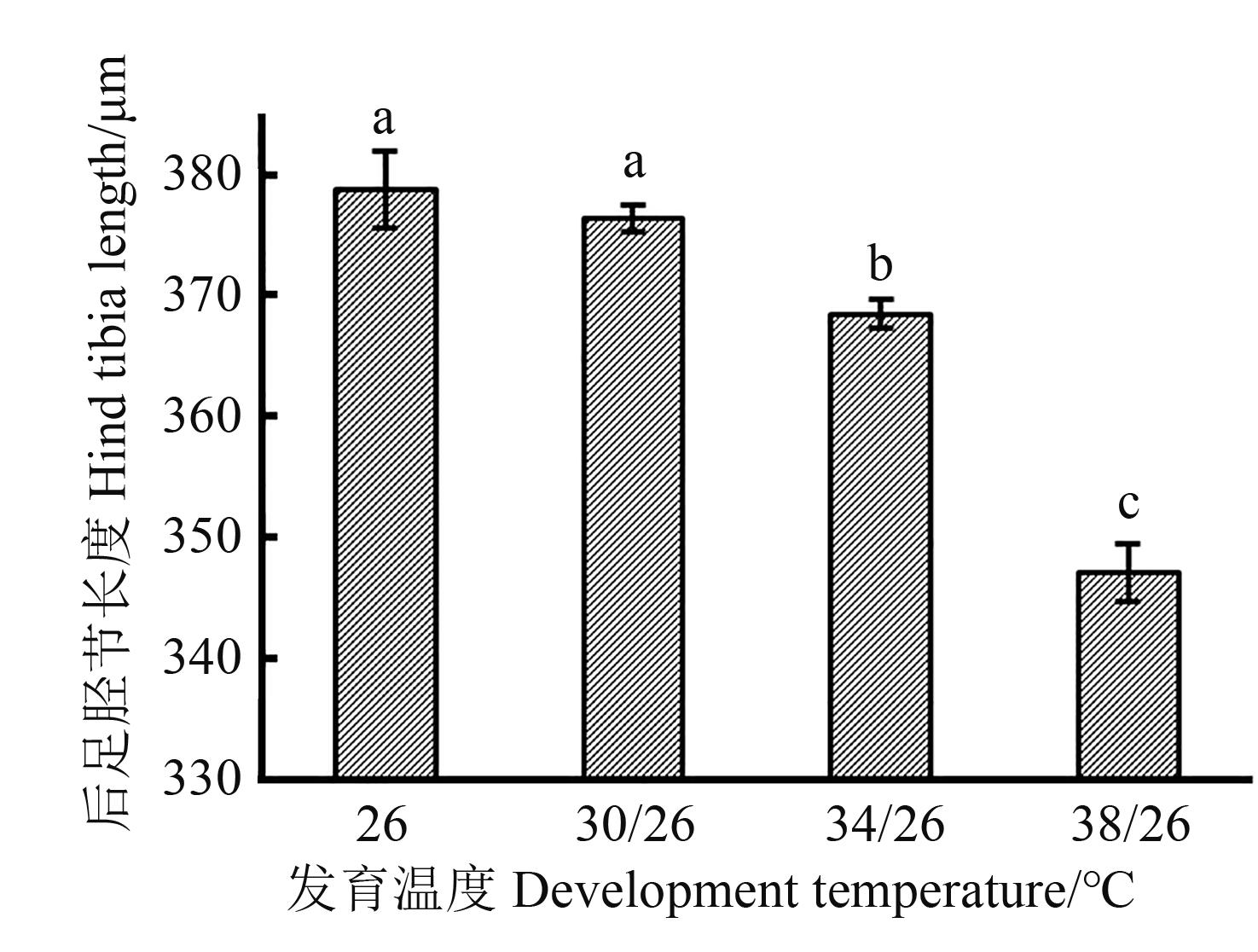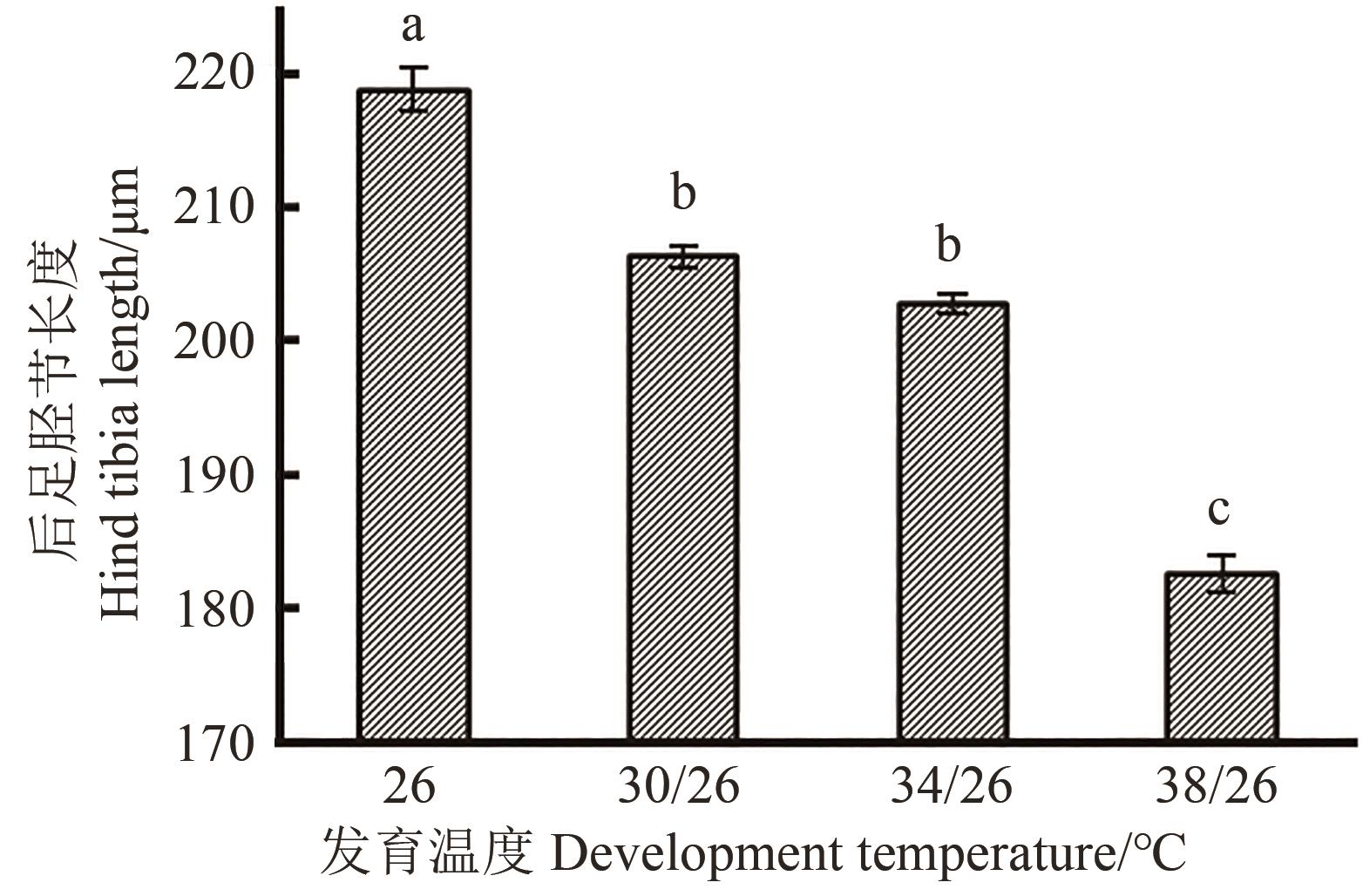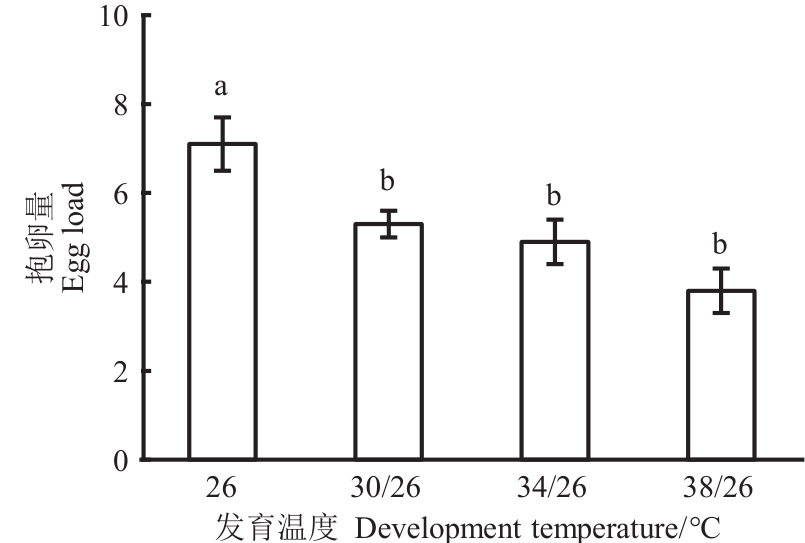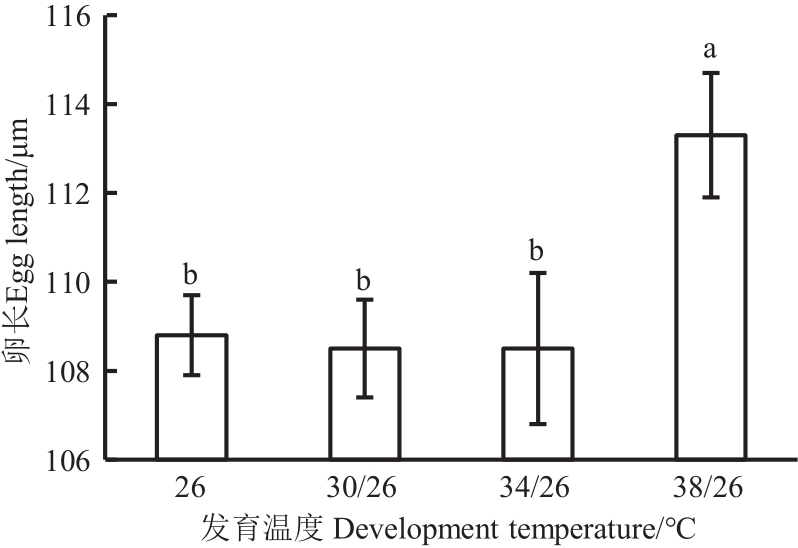




















中国农业科技导报 ›› 2023, Vol. 25 ›› Issue (5): 131-138.DOI: 10.13304/j.nykjdb.2023.0021
• 动植物健康 • 上一篇
收稿日期:2023-01-06
接受日期:2023-03-07
出版日期:2023-05-20
发布日期:2023-07-13
通讯作者:
徐海云
作者简介:冯雪莹 E-mail:fxy970110@163.com;
基金资助:
Xueying FENG( ), Lukuan WANG, Yucui HUANG, Chunping YANG, Haiyun XU(
), Lukuan WANG, Yucui HUANG, Chunping YANG, Haiyun XU( )
)
Received:2023-01-06
Accepted:2023-03-07
Online:2023-05-20
Published:2023-07-13
Contact:
Haiyun XU
摘要:
为揭示气候变暖背景下温度升高对农业害虫-天敌系统的作用规律,研究不同程度高温条件对烟粉虱及其优势寄生蜂丽蚜小蜂适合度和同步性的影响。分别于恒定适温(26 ℃)和高/适温交替(30/26、34/26和38/26 ℃)条件下逐日观察统计烟粉虱和丽蚜小蜂成虫前期各阶段的发育历期、存活率和初羽化雌成虫个体大小,并解剖初羽化丽蚜小蜂雌蜂卵巢,统计其抱卵量及卵子长度。结果显示,烟粉虱卵-1龄若虫、2龄若虫和3龄若虫各阶段的发育历期随着温度的升高而逐渐缩短;整个成虫前期的发育历期在30/26、34/26和38/26 ℃高/适温交替条件下比26 ℃恒定适温下分别缩短1.6、1.9和4.4 d;34/26和38/26 ℃时初羽化雌成虫个体明显变小。高/适温交替条件下丽蚜小蜂卵-幼虫期和蛹期的发育历期均明显缩短;整个成虫前期的发育历期在30/26、34/26和38/26 ℃温度下比26 ℃适温下分别缩短2.2、2.0和3.0 d;随着温度的升高,丽蚜小蜂初羽化雌蜂个体变小,卵巢内成熟卵子数量显著下降。由此可见,发育温度的升高,显著影响烟粉虱和丽蚜小蜂的适合度,二者的同步性发生改变。研究结果表明在生防实践中应充分考虑环境温度变化对烟粉虱及寄生蜂影响的差异性,合理制定烟粉虱的生防策略。
中图分类号:
冯雪莹, 王路宽, 黄玉翠, 杨春萍, 徐海云. 发育高温对烟粉虱及其优势寄生蜂适合度和同步性的影响[J]. 中国农业科技导报, 2023, 25(5): 131-138.
Xueying FENG, Lukuan WANG, Yucui HUANG, Chunping YANG, Haiyun XU. Effects of High Temperature on Fitness and Synchrony of Bemisia tabaci and Its Dominate Parasitoid[J]. Journal of Agricultural Science and Technology, 2023, 25(5): 131-138.
时间 Time | 恒定适温 Constant optimum temperature/℃ | 高/适温交替 Alternating high/optimum temperature/℃ | ||
|---|---|---|---|---|
| 26 | 30/26 | 34/26 | 38/26 | |
| 0:00—10:00 | 26 | 26 | 26 | 26 |
| 10:00—15:00 | 26 | 30 | 34 | 38 |
| 15:00—24:00 | 26 | 26 | 26 | 26 |
表1 每日温度设置
Table 1 Daily temperature setting
时间 Time | 恒定适温 Constant optimum temperature/℃ | 高/适温交替 Alternating high/optimum temperature/℃ | ||
|---|---|---|---|---|
| 26 | 30/26 | 34/26 | 38/26 | |
| 0:00—10:00 | 26 | 26 | 26 | 26 |
| 10:00—15:00 | 26 | 30 | 34 | 38 |
| 15:00—24:00 | 26 | 26 | 26 | 26 |
温度 Temperature/℃ | 发育历期 Development period/d | ||||
|---|---|---|---|---|---|
卵-1龄 Egg-1st instar | 2龄 2nd instar | 3龄 3rd instar | 4龄 4th instar | 卵-成虫 Egg-adult | |
| 26 | 8.9±0.1 a | 3.0±0.1 a | 3.5±0.1 a | 2.6±0.1 a | 18.0±0.2 a |
| 30/26 | 8.4±0.1 a | 2.8±0.1 ab | 2.9±0.3 ab | 2.3±0.2 a | 16.4±0.6 ab |
| 34/26 | 8.2±0.2 a | 2.6±0.1 b | 2.8±0.2 ab | 2.4±0.1 a | 16.1±0.3 bc |
| 38/26 | 6.2±0.2 b | 2.5±0.1 b | 2.5±0.2 b | 2.4±0.1 a | 13.6±0.5 c |
表2 不同温度下烟粉虱成虫前期各阶段发育历期
Table 2 Development duration of each stage of Bemisia tabaci pre-adult under different temperatures
温度 Temperature/℃ | 发育历期 Development period/d | ||||
|---|---|---|---|---|---|
卵-1龄 Egg-1st instar | 2龄 2nd instar | 3龄 3rd instar | 4龄 4th instar | 卵-成虫 Egg-adult | |
| 26 | 8.9±0.1 a | 3.0±0.1 a | 3.5±0.1 a | 2.6±0.1 a | 18.0±0.2 a |
| 30/26 | 8.4±0.1 a | 2.8±0.1 ab | 2.9±0.3 ab | 2.3±0.2 a | 16.4±0.6 ab |
| 34/26 | 8.2±0.2 a | 2.6±0.1 b | 2.8±0.2 ab | 2.4±0.1 a | 16.1±0.3 bc |
| 38/26 | 6.2±0.2 b | 2.5±0.1 b | 2.5±0.2 b | 2.4±0.1 a | 13.6±0.5 c |
温度 Temperature/℃ | 存活率 Survival rate/% | 累计存活率 Cumulative survival rate/% | ||
|---|---|---|---|---|
1龄 1st instar | 2龄 2nd instar | 3龄 3rd instar | ||
| 26 | 84.22±3.61 a | 95.36±1.01 a | 97.66±1.18 a | 78.22±2.64 a |
| 30/26 | 90.78±1.74 a | 93.79±2.45 a | 97.17±1.77 a | 82.57±0.70 a |
| 34/26 | 92.86±3.28 a | 98.57±1.42 a | 92.23±3.05 a | 84.17±2.86 a |
| 38/26 | 85.68±2.89 a | 94.09±1.85 a | 95.22±2.33 a | 76.51±1.36 a |
表3 不同温度下烟粉虱1~3龄期若虫存活率
Table 3 Survival rates of Bemisia tabaci 1st to 3rd nymph under different temperature
温度 Temperature/℃ | 存活率 Survival rate/% | 累计存活率 Cumulative survival rate/% | ||
|---|---|---|---|---|
1龄 1st instar | 2龄 2nd instar | 3龄 3rd instar | ||
| 26 | 84.22±3.61 a | 95.36±1.01 a | 97.66±1.18 a | 78.22±2.64 a |
| 30/26 | 90.78±1.74 a | 93.79±2.45 a | 97.17±1.77 a | 82.57±0.70 a |
| 34/26 | 92.86±3.28 a | 98.57±1.42 a | 92.23±3.05 a | 84.17±2.86 a |
| 38/26 | 85.68±2.89 a | 94.09±1.85 a | 95.22±2.33 a | 76.51±1.36 a |

图1 不同发育温度下烟粉虱雌虫后足胫节长度注:不同小写字母表示差异在P<0.05水平显著。
Fig. 1 Hind tibia length of Bemisia tabaci female under different development temperaturesNote: Different lowercase letters indicate significant differences at P<0.05 level.
温度 Temperature/℃ | 发育历期 Development period/d | ||
|---|---|---|---|
卵-幼虫 Egg-larva | 蛹 Pupa | 卵-成虫 Egg-adult | |
| 26 | 8.1±0.1 a | 7.7±0.1 a | 15.8±0.1 a |
| 30/26 | 7.2±0.1 bc | 6.4±0.1 b | 13.6±0.1 b |
| 34/26 | 7.4±0.1 b | 6.4±0.1 b | 13.8±0.1 b |
| 38/26 | 7.0±0.2 c | 5.8±0.1 c | 12.8±0.1 c |
表4 不同温度下丽蚜小蜂成虫前期各阶段发育历期
Table 4 Development duration of each stage of Encarsia formosa pre-adult under different temperatures
温度 Temperature/℃ | 发育历期 Development period/d | ||
|---|---|---|---|
卵-幼虫 Egg-larva | 蛹 Pupa | 卵-成虫 Egg-adult | |
| 26 | 8.1±0.1 a | 7.7±0.1 a | 15.8±0.1 a |
| 30/26 | 7.2±0.1 bc | 6.4±0.1 b | 13.6±0.1 b |
| 34/26 | 7.4±0.1 b | 6.4±0.1 b | 13.8±0.1 b |
| 38/26 | 7.0±0.2 c | 5.8±0.1 c | 12.8±0.1 c |
温度 Temperature /ºC | 幼虫总数 No. of larvae | 化蛹总数 No. of pupae | 平均化蛹率 Average pupation rate/% |
|---|---|---|---|
| 26 | 195 | 172 | 84.4±5.3 a |
| 30/26 | 253 | 211 | 84.6±3.6 a |
| 34/26 | 184 | 163 | 90.1±2.7 a |
| 38/26 | 65 | 60 | 95.2±3.5 a |
表5 不同温度下丽蚜小蜂的平均化蛹率
Table 5 Average pupation rate of Encarsia formosa under different temperatures
温度 Temperature /ºC | 幼虫总数 No. of larvae | 化蛹总数 No. of pupae | 平均化蛹率 Average pupation rate/% |
|---|---|---|---|
| 26 | 195 | 172 | 84.4±5.3 a |
| 30/26 | 253 | 211 | 84.6±3.6 a |
| 34/26 | 184 | 163 | 90.1±2.7 a |
| 38/26 | 65 | 60 | 95.2±3.5 a |

图2 不同发育温度下丽蚜小蜂后足胫节长度注:不同小写字母表示差异在P<0.05水平显著。
Fig. 2 Hind tibia length of Encarsia formosa under different development temperaturesNote: Different lowercase letters indicate significant differences at P<0.05 level.

图3 不同发育温度下丽蚜小蜂抱卵量注:不同小写字母表示差异在P<0.05水平显著。
Fig. 3 Egg load of Encarsia formosa under different development temperaturesNote: Different lowercase letters indicate significant differences at P<0.05 level.

图4 不同发育温度下丽蚜小蜂雌蜂卵巢内卵子长度注:不同小写字母表示差异在P<0.05水平显著。
Fig. 4 Egg length of Encarsia formosa females under different development temperaturesNote: Different lowercase letters indicate significant differences at P<0.05 level.
| 1 | 李慧, 郝德君, 徐天, 等. 高温胁迫对植食性昆虫影响研究进展[J]. 南京林业大学学报(自然科学版), 2022, 46(6): 215-224. |
| LI H, HAO D J, XU T, et al.. The effects of heat stress on herbivorous insects: an overview and future directions [J]. J. Nanjing For. Univ. (Nat. Sci.), 2022, 46(6): 215-224. | |
| 2 | ABARCA M, SPAHN R. Direct and indirect effects of altered temperature regimes and phenological mismatches on insect populations [J]. Curr. Opin. Insect Sci., 2021, 47: 67-74. |
| 3 | 余文远, 张世泽. 天敌昆虫对温度胁迫的响应[J]. 陕西农业科学, 2022, 68(10): 90-96. |
| YU W Y, ZHANG S Z. Response of natural enemy insects to temperature stress [J]. Shaanxi Agric. Sci., 2022, 68(10): 90-96. | |
| 4 | HODKINSON I, BIRD J. Flexible responses of insect to changing environmental temperature-early season development of Craspedolepta species on fireweed [J]. Glob. Change Biol., 2006, 12(7): 1308-1314. |
| 5 | GAO G Z, FENG L K, PERKINS L E, et al.. Effect of the frequency and magnitude of extreme temperature on the life history traits of the large cotton aphid, Acyrthosiphon gossypii (Hemiptera: Aphididae): implications for their population dynamics under global warming [J]. Entomol. Gen., 2018, 37(2): 110-113. |
| 6 | ZHANG Y B, ZHANG G F, LIU W X, et al.. Continuous heat waves change the life history of a host-feeding parasitoid [J]. Biol. Control, 2019, 135:57-65. |
| 7 | GIBBS A G. Lipid melting and cuticular permeability: new insights into an old problem [J]. J. Insect Physiol., 2002, 48(4): 391-400. |
| 8 | WALTER M F, PETERSEN N S, BIESSMANN H. Heat shock causes the collapse of the intermediate filament cytoskeleton in Drosophila embryos [J]. Dev. Genetics, 1990, 11(4): 270-279. |
| 9 | LEITH N T, JOCSON D I, FOWLER-FINN K D. Temperature-related breakdowns in the coordination of mating in Enchenopa binotata treehoppers (Hemiptera: Membracidae) [J]. Ethology, 2020, 126(9): 870-882. |
| 10 | ZHANG Y B, YANG A P, ZHANG G F, et al.. Effects of simulated heat waves on life history traits of a host feeding parasitoid [J/OL]. Insects, 2019, 10(12): 419 [2022-12-06]. . |
| 11 | ZHAO M T, WANG Y, AHOU Z S, et al.. Effects of periodically repeated heat events on reproduction and ovary development of Agasicles hygrophila (Coleoptera: Chrysomelidae) [J]. J. Econ. Entomol., 2016, 109(4): 1586-1594. |
| 12 | HARVEY J A, HEINEN R, GOLS R, et al.. Climate change-mediated temperature extremes and insects: from outbreaks to breakdowns [J]. Glob. Change Biol., 2020, 26(12): 6685-6701. |
| 13 | MA C S, MA G, PINCEBOURDE S. Survive a warming climate: Insect responses to extreme high temperatures [J]. Annu. Rev. Entomol., 2021, 66: 163-184. |
| 14 | COLINET H, SINCLAIR B J, VERNON P, et al.. Insects in fluctuating thermal environments [J]. Annu. Rev. Entomol., 2015, 60: 123-140. |
| 15 | HANCE T, VAN BAAREN J, VERNON P, et al.. Impact of extreme temperatures on parasitoids in a climate change perspective [J]. Annu. Rev. Entomol., 2006, 52: 107-126. |
| 16 | JEFFS C T, LEWIS O T. Effects of climate warming on host-parasitoid interactions [J]. Ecol. Entomol., 2013, 38(3): 209-218. |
| 17 | SCHREVEN S J J, FRAGO E, STENS A, et al.. Contrasting effects of heat pulses on different trophic levels, an experiment with a herbivore-parasitoid model system [J/OL]. PLoS One, 2017, 12(4): e0176704 [2022-12-06]. . |
| 18 | BUCKLEY L B. Temperature-sensitive development shapes insect phenological responses to climate change [J/OL]. Curr. Opin. Insect Sci., 2022, 52: 100897 [2022-12-06]. . |
| 19 | ZHU L, WANG L, MA C S. Sporadic short temperature events cannot be neglected in predicting impacts of climate change on small insects [J]. J. Insect Physiol., 2018, 112: 48-56. |
| 20 | TONNANG H E Z, SOKAME B M, ABDEL-RAHMAN E M, et al.. Measuring and modelling crop yield losses due to invasive insect pests under climate change [J/OL]. Curr. Opin. Insect Sci., 2022, 50: 100873 [2022-12-06]. . |
| 21 | KLAPWIJK M J, CHRIS G B, WARD K, et al.. Influence of experimental warming and shading on host-parasitoid synchrony [J]. Glob. Change Biol., 2010, 16: 102-112. |
| 22 | THOMSON L, MACFADYEN S, HOFFMANN A A. Predicting the effects of climate change on natural enemies of agricultural pests [J]. Biol. Control, 2010, 52(3): 296-306. |
| 23 | STIREMAN J, DYER L A, JANZEN D H, et al.. Climatic unpredictability and parasitism of caterpillars: implications of global warming [J]. P. Natl. Acad. Sci. USA, 2005, 102(48): 17384-17387. |
| 24 | BERG M P, KIERS E T, DRIESSEN G, et al.. Adapt or disperse: understanding species persistence in a changing world [J]. Glob. Change Biol., 2010, 16(2): 587-598. |
| 25 | 张吉松, 张卓, 张德咏, 等. 烟粉虱MEAM1和MED成虫在辣椒上传播番茄褪绿病毒的特性[J]. 昆虫学报, 2022, 65(11): 1452-1458. |
| ZHANG J S, ZHANG Z, ZHANG D Y, et al.. Transmission characteristics of Tomato chlorosis virus on Capsicum annuuum by adult Bemisia tabaci MEAM1 and MED (Hemiptera: Aleyrodidae) [J]. Acta Entomol. Sin., 2022, 65(11): 1452-1458. | |
| 26 | WEI K K, LI J, DING T B, et al.. Transmission characteristics of Tomato chlorosis virus (ToCV) by Bemisia tabaci MED and its effects on host preference of vector whitefly [J]. J. Integr. Agric., 2019, 18(9): 2107-2114. |
| 27 | 何笙,吴晓云,郑金竹,等. 丽蚜小蜂防治设施番茄烟粉虱效果研究[J]. 安徽农业科学,2013, 41(14):6244-6245, 6248. |
| HE S, WU X Y, ZHENG J Z, et al.. A Study of control effect of Bemisia tabaci (Gennadius) on greenhouse tomatoes using parasitoid Encarsia formosa gahan [J]. J. Anhui Agric. Sci., 2013, 41(14):6244-6245, 6248. | |
| 28 | 陶笑,张晨阳,付文燕,等. 丽蚜小蜂防治设施番茄烟粉虱的效果研究[J]. 长江蔬菜,2018(6): 78-82. |
| TAO X, ZHANG C Y, FU W Y, et al.. Control efficacy of tomato Bemisia tabaci by using Encarsia formosa gahan in greenhouse [J]. J. Changjiang Veg., 2018(6): 78-82. | |
| 29 | BAYHAN E, ULUSOY M R, BROWN J K. Effects of different cucurbit species and temperature on selected life history traits of the ‘B’ biotype of Bemisia tabaci [J]. Phytoparasitica, 2006, 34: 235-242. |
| 30 | GUO L, SU M M, LIANG P, et al.. Effects of high temperature on insecticide tolerance in whitefly Bemisia tabaci (Gennadius) Q biotype [J]. Pestic. Biochem. Phys., 2018, 150: 97-104. |
| 31 | 陈婷. Q型烟粉虱对高温胁迫的生理和生殖响应机制[D]. 北京: 中国农业科学院, 2011. |
| CHEN T. Physiological and reproductive responses of Bemisia tabaci (Gennadius) Q-biotype to high temperature stress [D]. Beijing: Chinese Academy of Agricultural Sciences, 2011. | |
| 32 | 杨艺炜, 刘晨, 任平, 等. 烟粉虱对高温和低温胁迫响应及生态防控策略[J]. 西北农业学报, 2021, 30(5): 782-788. |
| YANG Y W, LIU C, REN P, et al.. Response of Bemisia tabaci to high and low temperature stress and ecological control measures [J]. Acta Agric. Bor-Occid. Sin., 2021, 30(5): 782-788. | |
| 33 | ZANDI-SOHANI N, SHISHEHBOR P. Temperature effects on the development and fecundity of Encarsia acaudaleyrodis (Hymenoptera: Aphelinidae), a parasitoid of Bemisia tabaci (Homoptera: Aleyrodidae) on cucumber [J]. Biol. Control, 2011, 56: 257-263. |
| 34 | QIU B L, BARRO P J D, XU R C X. Effect of temperature on the life history of Eretmocerus sp. nr. furuhashii, a parasitoid of Bemisia tabaci [J]. Biol. Control, 2007, 52: 733-746. |
| 35 | COLINET H, BOIVIN G, HANCE T. Manipulation of parasitoid size using the temperature-size rule: fitness consequences [J]. Oecologia, 2007, 152(3): 425-433. |
| 36 | 林克剑, 吴孔明, 魏洪义, 等. 温度和湿度对B型烟粉虱发育、存活和生殖的影响[J]. 植物保护学报, 2004, 31(2): 166-172. |
| LIN K J, WU K M, WEI H Y, et al.. Effects of temperature and humidity on the development, survival and reproduction of B biotype of Bemisia tabaci (Homoptera: Aleyrodidae) from Beijing [J]. Acta Phytophy. Sin, 2004, 31(2): 166-172. | |
| 37 | 周淑香, 李玉, 张帆. 高温冲击对沃尔巴克氏体(Wolbachia)诱导孤雌产雌的丽蚜小蜂(Encarsia formosa)生殖和发育的影响[J]. 生态学报, 2009, 29(9): 4732-4737. |
| ZHOU S X, LI Y, ZHANG F. Influences of high temperature shock on the reproduction and development of the Wolbachia-induced parthenogenetic parasitoid wasp, Encarsia formosa (Gahan) [J]. Acta Ecol. Sin., 2009, 29(9): 4732-4737. | |
| 38 | FISCHBEIN D, CORLEY G C. Population ecology and classical biological control of forest insect pests in a changing world [J/OL]. For. Ecol. Manag., 2022, 520: 120400 [2022-12-06]. . |
| 39 | DUAN J J, LARSON K L. Effects of chilling on diapause development and reproductive fitness of two congeneric species of encyrtid parasitoids (Hymenoptera: Encyrtidae) of the emerald ash borer [J]. Biol. Control, 2019, 134: 163-169. |
| 40 | ELLERS J, BAX M, VAN ALPHEN J J M. Seasonal changes in female size and its relation to reproduction in the parasitoid Asobara tabida [J]. Oikos, 2001, 92: 309-314. |
| 41 | SAGARRA L, VINCENT C, STEWART R. Body size as an indicator of parasitoid quality in male and female Anagyrus kamali (Hymenoptera: Encyrtidae) [J]. B. Entomol. Res., 2001, 91(5): 363-367. |
| 42 | BLANCKENHORN W U, BERGER D, ROHNER P T, et al.. Comprehensive thermal performance curves for yellow dung fly life history traits and the temperature-size-rule [J/OL]. J. Therm. Biol., 2021, 100: 103069 [2022-12-06]. . |
| 43 | BOCHDANOVITS Z, DE JONG G. Temperature dependent larval resource allocation shaping adult body size in Drosophila melanogaster [J]. J. Evolution. Biol., 2003, 16: 1159-1167. |
| 44 | LANN C L, WARDZIAK T, VAN BAAREN J, et al.. Thermal plasticity of metabolic rates linked to life-history traits and foraging behavior in a parasitic wasp [J]. Funct. Ecol., 2011, 25(3): 641-651. |
| 45 | WAAGE J K, MING N S. The reproductive strategy of a parasitic wasp. I. Optimal progeny and sex allocation in Trichogramma evanescens [J]. J. Anim. Ecol., 1984, 53: 401-415. |
| 46 | BAI B, LUCK R F, FORSTER L, et al.. The effect of host size on quality attributes of the egg parasitoid, Trichogramma pretiosum [J]. Entomol. Exp. Appl., 1992, 64: 37-48. |
| 47 | RENOZ F, PONS I, HANCE T. Evolutionary responses of mutualistic insect-bacterial symbioses in a world of fluctuating temperatures [J]. Curr. Opin. Insect Sci., 2019, 35: 20-26. |
| [1] | 金辉, 王伟, 颜尘栋, 王薇, 李熙英. 水稻纹枯病生防木霉菌分离鉴定及适应性研究[J]. 中国农业科技导报, 2022, 24(9): 139-148. |
| [2] | 林志坚, 陈长江, 周挺, 顾钢, 胡方平, 李春英, 蔡学清. 青枯菌噬菌体RPZH6株系对烟草青枯病的生防效果及全基因组测序分析[J]. 中国农业科技导报, 2022, 24(10): 133-142. |
| [3] | 赵兴丽1,陶刚2,3*,娄璇4,顾金刚5*. 钩状木霉在辣椒根际定殖动态及其对辣椒疫病的生物防治[J]. 中国农业科技导报, 2020, 22(5): 106-114. |
| [4] | 周红姿1,周方园1,赵晓燕1,吴翠霞2,张广志1,苑伟伟3,吴晓青1,谢雪迎1,范素素1,张新建1*. 小麦赤霉病生防菌的筛选及其田间防效研究[J]. 中国农业科技导报, 2020, 22(1): 67-77. |
| [5] | 路露1,2,张孟丽2,狄怡琳2,朱凯1*,石宝俊2*. 百里香酚对不同时期秀丽线虫杀虫效果探究[J]. 中国农业科技导报, 2019, 21(9): 97-103. |
| [6] | 吴晓青1,赵晓燕1,徐元章2,王加宁1,周方园1,周红姿1,张广志1,谢雪迎1,颜坤3,张新建1*. 植物生物防治精准化施药技术的研究进展[J]. 中国农业科技导报, 2019, 21(3): 13-21. |
| [7] | 冯雪莹1,张毅波2,黄玉翠1,郭梦然1,孟烨1,张晓明3,徐海云1*. 雄安新区及其周边地区烟粉虱的种群动态及空间分布格局[J]. 中国农业科技导报, 2019, 21(10): 115-124. |
| [8] | 程亮1,2,郭青云1,2*. 燕麦镰刀菌GD\|2菌株作为生物除草剂的潜力研究(英文)[J]. , 2014, 16(3): 70-80. |
| [9] | 邱德文. 生物农药与生物防治发展战略浅谈[J]. , 2011, 13(5): 88-92. |
| [10] | 吕宁*,王祺*,宋娟,张一名,周洪友. 甜瓜采后病害生防菌遗传改良及其相关性状初步分析[J]. , 2011, 13(2): 25-30. |
| [11] | 路雪君1,2,廖晓兰1,成飞雪2,刘勇2. 根结线虫的生物防治研究进展[J]. , 2010, 12(4): 44-48. |
| [12] | 王鑫1,匡炜1,2,万方浩1. 番茄抗性基因Mi-1研究进展[J]. , 2009, 11(5): 23-29. |
| [13] | 闫培生,曹立新,王凯,王琢. 真菌毒素生物防治研究进展[J]. , 2008, 10(6): 89-94. |
| [14] | 宋晓妍 孙彩云 陈秀兰 张玉忠. 木霉生防作用机制的研究进展[J]. , 2006, 8(6): 20-25. |
| [15] | 江洪涛 张红梅. 国内外水葫芦防治研究综述[J]. , 2003, 5(3): 72-75. |
| 阅读次数 | ||||||
|
全文 |
|
|||||
|
摘要 |
|
|||||
 京公网安备11010802021197号
京公网安备11010802021197号